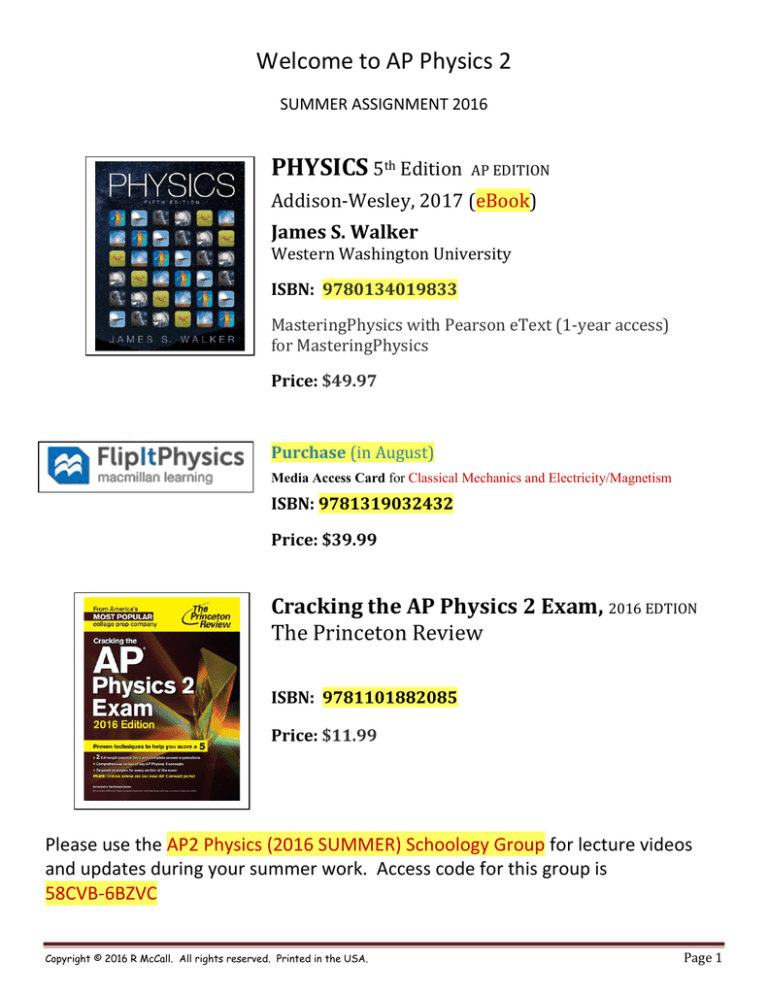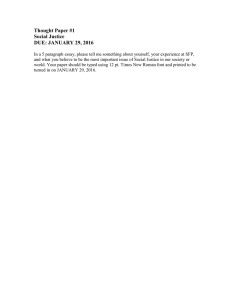
Welcome to AP Physics 2
SUMMER ASSIGNMENT 2016
PHYSICS 5th Edition
AP EDITION
Addison-Wesley, 2017 (eBook)
James S. Walker
Western Washington University
ISBN: 9780134019833
MasteringPhysics with Pearson eText (1-year access)
for MasteringPhysics
Price: $49.97
Purchase (in August)
Media Access Card for Classical Mechanics and Electricity/Magnetism
ISBN: 9781319032432
Price: $39.99
Cracking the AP Physics 2 Exam, 2016 EDTION
The Princeton Review
ISBN: 9781101882085
Price: $11.99
Please use the AP2 Physics (2016 SUMMER) Schoology Group for lecture videos
and updates during your summer work. Access code for this group is
58CVB-6BZVC
Copyright © 2016 R McCall. All rights reserved. Printed in the USA.
Page 1
Materials:
A composition notebook for daily work, and homework problems
A small amount of college ruled paper
A scientific graphing calculator (TI-83, TI-84, etc.)
A clear plastic metric ruler
Pencils (NO PENS!) to be brought to class every day (mechanical pencils preferred)
USB Flash drive (for downloading online physics information)
You have embarked upon a wonderful adventure! You have made a great decision and a
powerful commitment in taking AP Physics 2!!
This summer assignment has a two-fold purpose:
First, to decrease the amount of new material that you will have to master during the school year
for the AP Exam in May 2017.
Second, to present an opportunity for you to earn some early strong grades as you begin the first
quarter with confidence.
AP Physics 2 Summer Assignment: 2016
1. Obtain the textbook, and the bound quadrille notebook. These items will make the summer
assignment easier and clearer.
2. Read the Introduction and Chapters 2-5. This is MOTION, VECTORS, AND FORCES Review. Please
take detailed notes on the introduction and each chapter. You have plenty of time to complete each
chapter – DON’T WAIT UNTIL THE LAST MINUTE!!
3. A reading quiz for each chapter will be in the form of two (open-notes) in-class quizzes during the
first week of class. This will be in MasteringPhysics.
5. Another attachment to this summer assignment is the IN-CLASS EXAMPLE PROBLEMS from Chapters
2-5 to complete. The IN-CLASS EXAMPLE PROBLEMS are included in this packet. The most important
thing in this problem assignment is your completely worked-out solutions. The problems will be
graded on your worked out solutions.
Incomplete or absent work = NO CREDIT! Show me ALL the steps!
6. On July 15th the answers to the IN-CLASS EXAMPLE PROBLEMS will be available on this course site.
7. All the worked-out solutions to the IN-CLASS EXAMPLE PROBLEMS, and the detailed notes from
each chapter are due the first day of class at the beginning of class!
You will not receive credit if you do not turn in these on the first day of class. There are NO EXCUSES.
Questions??? Contact Mr. McCall
mccallr@bishopmoore.org
Copyright © 2016 R McCall. All rights reserved. Printed in the USA.
Page 2
PHYSICS BASICS, MOTION, & FORCES
READING & NOTES, PROBLEMS, AND ANSWERS
CHAPTER 2
ONE DIMENSIONAL KINEMATICS
1)
Complete detailed notes from your reading of Chapter 2.
2)
Complete IN-CLASS EXAMPLE PROBLEMS on pages 4-7 of this packet.
CHAPTER 3
VECTORS IN PHYSICS
1)
Complete detailed notes from your reading of Chapter 3.
2)
Complete IN-CLASS EXAMPLE PROBLEMS on pages 4-7 of this packet.
CHAPTER 4
TWO DIMENSIONAL KINEMATICS
1)
Complete detailed notes from your reading of Chapter 4.
2)
Complete IN-CLASS EXAMPLE PROBLEMS on pages 4-7 of this packet.
CHAPTER 5
NEWTON’S LAWS OF MOTION
1)
Complete detailed notes from your reading of Chapter 5.
2)
Complete IN-CLASS EXAMPLE PROBLEMS on pages 4-7 of this packet.
Copyright © 2016 R McCall. All rights reserved. Printed in the USA.
Page 3
AP Physics 2
PHYSICS BASICS, MOTION, & VECTORS
CH 2-4 IN-CLASS EXAMPLE PROBLEMS
DISPLACEMENT, VELOCITY, & ACCELERATION
1.
A car is moving in the negative direction at a velocity of -9.00 m/s. It then undergoes a positive acceleration of +0.40 m/s2 for
10.0 seconds. What is the car’s velocity at the end of the acceleration?
2.
Two trains are traveling in the same direction on parallel tracks, where train A is moving at 50.0 km/h, and train B is moving at
60.0 km/h. If train B is initially 20.0 km behind train A, how long will it take for train A to catch up to train B?
KINEMATICS
3.
In 1865 Jules Verne proposed sending men to the Moon by firing a space capsule from a 220.0 m-long cannon, where they
would have exited the cannon traveling at 10.97 km/s. What would have been the unrealistically large acceleration experienced
by the space travelers during the launch?
4.
A certain arrow is accelerated by a bowstring at a rate of 42.0 m/s 2. Assuming it starts from rest, how much time is required for
the arrow to travel through the first 15.0 cm displacement during its acceleration?
FREE-FALL
5.
A ball is thrown straight upward from ground level at a speed of 15.0 m/s. How much time passes before the ball lands back at
the same height from which it was thrown? (Neglect any effects of air resistance.)
Copyright © 2016 R McCall. All rights reserved. Printed in the USA.
Page 4
6.
A model rocket is launched straight upward from rest at ground level. It accelerates with a constant upward acceleration of 2.0
m/s2 until its engines stop at an altitude of 150.0 m. Assuming no parachute opens up, and no air resistance in general, how
much total time does it take for the rocket to reach its highest point?
VECTORS
7.
A toy airplane moves upward for 15.0 m at 10.0 above the horizontal, then travels 20.0 m at 14.0 below the horizontal.
a. What are the x- and y- components of the plane’s first displacement?
b. What is the plane’s total displacement?
PROJECTILES
8.
A projectile is launched horizontally at 12.0 m/s from the top of a building that is 40.0 m tall. How far does the projectile move
horizontally before it lands on the ground?
9.
A stone is kicked horizontally off of a 90m-tall cliff, at an initial speed of 23.0 m/s. How fast is the stone moving at the moment
that it strikes the ground?
10. A bullet is fired upward from ground level with an initial velocity of 200.0 m/s at 42.0 above the horizontal. What is the highest
point above ground level reached by the bullet? (Neglect any effects of air resistance.)
11. A ball is launched from a cliff at an initial angle of 35.0 to the horizontal, at a speed of 30m/s. What is its speed at the time it
has moved 200.0 m in the horizontal direction?
Copyright © 2016 R McCall. All rights reserved. Printed in the USA.
Page 5
AP Physics 2
FORCES AND APPLYING NEWTON’S LAWS
CH 5 IN-CLASS EXAMPLE PROBLEMS
NEWTON’S 2ND LAW
1.
A 2.00 kg box is sitting at rest on the ground. A rope is tied to the box pulling it to the right, while a frictional force acts to the
left, opposing the box’s motion.
a)
If a 10.0 N tension force is required to pull the box at a constant velocity, calculate the frictional force acting on the box.
b) Assuming the same frictional force continues to act on the moving box, how quickly will the box accelerate if the rightward
tension force is increased to a 15.0 N force?
c)
Assuming the same frictional force continues to act on the moving box, what rightward tension force will cause the box to
speed up at a rate of 4.0 m/s2?
d) Assuming the same frictional force continues to act on the moving box, what rightward tension force will cause the box to
slow down at a rate of 3.0 m/s2?
WEIGHT AND NORMAL FORCE
2.
A 5.00 kg rock is sitting on a scale on the floor of an elevator.
a)
Assuming the elevator is at rest, find the weight of the rock, and the normal force exerted on the rock by the scale.
b) Now the elevator accelerates upward at 2.30 m/s2. Find the weight of the rock and the normal force acting on the rock.
Copyright © 2016 R McCall. All rights reserved. Printed in the USA.
Page 6
3.
A fisherman pulls a fish vertically out of the water with an acceleration of 2.50 m/s 2, while using very light fishing line that has a
breaking strength of 22.0 N. Unfortunately, the line snaps under these conditions. What do you know about the mass of the
fish?
CONNECTED OBJECTS
4.
Three objects are connected as shown in the picture, and are moving across a frictionless surface.
a)
If a 50.0 N horizontal force pulls the front block to the right, find the acceleration of the whole system.
b) Now find the tension in the cord connecting the front two blocks.
5.
Two objects are connected by a light string that runs over a lightweight pulley. If the two objects have masses of 5.00 kg and
8.00 kg, find the acceleration of the system.
Copyright © 2016 R McCall. All rights reserved. Printed in the USA.
Page 7
AP2 PHYSICS
2016-2017 COURSE SYLLABUS
1st SEMESTER:
UNIT 1:
Chapter 2-5
AP2 PHYSICS INTRO AND MECHANICS REVIEW
UNIT 2:
Chapters 15
STATIC FLUID AND FLUIDS IN MOTION
UNIT 3:
Chapter 16-17
TEMPERATURE, HEAT, AND PHASE CHANGES
UNIT 4:
Chapters 18
LAWS OF THERMODYNAMICS
UNIT 5:
Chapters 19-20
ELECTROSTATICS
UNIT 6:
Chapters 21
ELECTRIC CURRENT AND DC CIRCUITS
(approximately 21 days)
(approximately 20 days)
(approximately 14 days)
(approximately 14 days)
(approximately 14 days)
Cumulative Semester Exam
(approximately 15 days)
(UNITS 1-6)
Copyright © 2016 R McCall. All rights reserved. Printed in the USA.
TEST #1 – AUG 26
TEST #2 – SEPT 16
TEST #3 – SEPT 30
TEST #4 – OCT 21
TEST #5 – NOV 11
TEST #6 – DEC 02
DEC 13 - 16
Page 8
2nd SEMESTER:
UNIT 7:
Chapter 22-23
MAGNETISM AND ELECTROMAGNETIC INDUCTION
(approximately 14 days)
UNIT 8:
Chapter 25-26, 28
LIGHT AND GEOMETRIC OPTICS
UNIT 9:
Chapters 30
QUANTUM PHYSICS
UNIT 10:
Chapters 31-32
ATOMIC AND NUCLEAR PHYSICS
UNIT 11:
REVIEW SEMESTER 1 CONCEPTS
(approximately 14 days)
(approximately 11 days)
(approximately 18 days)
(approximately 16 days)
UNIT 12:
TEST #1 – JAN 20
TEST #2 – FEB 10
TEST #3 – FEB 17
TEST #4 – MAR 03
TEST #5 – MAR 24
REVIEW SEMESTER 2 CONCEPTS
(approximately 14 days)
TEST #6 – APR 28
MOCK EXAM – SATURDAY, APR 08
AP PHYSICS 2 EXAM MAY 3 (WEDNESDAY AFTERNOON)
Copyright © 2016 R McCall. All rights reserved. Printed in the USA.
Page 9



